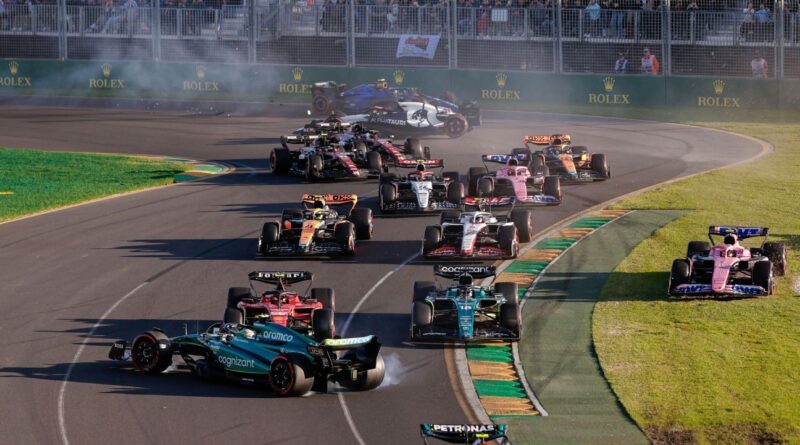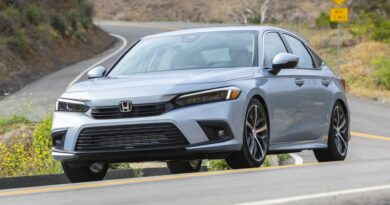Ferrari’s request to review Sainz penalty dismissed
The Australian Grand Prix’s stewards have rejected Ferrari’s attempt to reopen the investigation into Carlos Sainz’s in-race penalty.
Sainz dropped from fourth place to last in the final results of the race due to a five-second penalty for making contact with Fernando Alonso at a late red-flag restart.
The stewards issued the penalty during the third and final red flag before a safety car finish and found the Ferrari driver wholly to blame for the collision.
Sainz was livid with the decision over team radio, saying it was the “most unfair penalty I’ve seen in my life”.
He also said the stewards should have waited to hear from him before making a decision — something the stewards do not have to do if they issue an in-race penalty.
After the race, Ferrari lodged a petition to review the stewards’ decision, which, if successful, would have seen the stewards reconsider their decision and potentially alter the result of the race.
However, in order to reopen the case Ferrari was required to provide new and relevant information that had not been available to the stewards at the time of the decision.
Ferrari presented the following three elements:
a) the telemetry data of Sainz’s car after the second restart.
b) Sainz’s witness statement; and
c) other driver’s witness statements, which amount to records of post-race interviews given by Alonso as well as other drivers.
All three were rejected.
Ferrari also believed there was a precedent for reopening the case based on an accident between Sergio Perez and Felipe Massa at the 2014 Canadian Grand Prix.
The investigation into that incident was reopened as Perez, who was driving for Force India at the time, had been hospitalised after the crash and was unable to attend the post-race hearing into the accident.
Despite reopening the case, Perez’s penalty, which was a grid drop at the next race, was upheld.
However, the Australian Grand Prix stewards said the two incidents were not comparable.
“The distinguishing feature here is that our decision [regarding Sainz in Australia] was made in-race,” a statement said. “We deemed it unnecessary for us to hear from SAI or hear from any other driver to decide that he was wholly to blame for the collision.
“A decision that we, and other Stewards panels, routinely take and are encouraged to take, when the cause of the collision is clear and there is a need for time penalties to be issued as quickly as possible.”
The stewards went on to explain why they had rejected all three elements presented by Ferrari.
“a) Telemetry: The telemetry data of itself is not a significant and relevant new element required to decide who was at fault for the collision. The Stewards have access to a considerable amount of telemetry data. We were also in a position to access such data. The telemetry data presented in the Petition is at best ambiguous and in our view did not exculpate SAI but in fact corroborated our decision that he was wholly to blame for the collision. He says he braked harder but could not stop the car because of cold tyres. He states further that a slow formation lap contributed to the cold tyres.
“There are two short points. First, even if that is true, the presentation of telemetry showing his braking point is not a significant new element for the purposes of Art.14.
“Second, the conditions of the track and the tyres was something that every competitor needed to take into account and adapt to. In trying to brake late while racing GAS, he adopted the risk that he, as a driver, would lose control of his car. In this case, that risk materialised, with the consequence of a collision that ensued, for which a penalty follows.
“b) SAI’s written witness statement (the document itself) is not a new significant and relevant element required to decide who was at fault for the collision. First, had we thought that this required a statement from SAI for us to analyse the event, we would have summoned him after the race. We did not consider it necessary then to hear from him to decide that fact.
“His witness statement, in essence, states how poor the grip was (we have dealt with why that is not a sufficient excuse above) and how the sun was in his eyes. But logic would dictate that the position of the sun would have equally impacted other drivers too. It is not a justifiable reason to avoid a penalty for a collision. The witness statement is therefore not a new element either.
“c) The other drivers’ statements are not new significant and relevant elements required to decide about the incident (none of the statements contained new significant and relevant versions about the collision). These statements were all records of post-race statements given by the drivers to the media. These were presented to corroborate their position that the grip level was low and that the tyres were cold.”
Source : Autonews.com




